climate control RENAULT TWINGO RS 2009 2.G Air Conditioning Owner's Guide
[x] Cancel search | Manufacturer: RENAULT, Model Year: 2009, Model line: TWINGO RS, Model: RENAULT TWINGO RS 2009 2.GPages: 122
Page 87 of 122
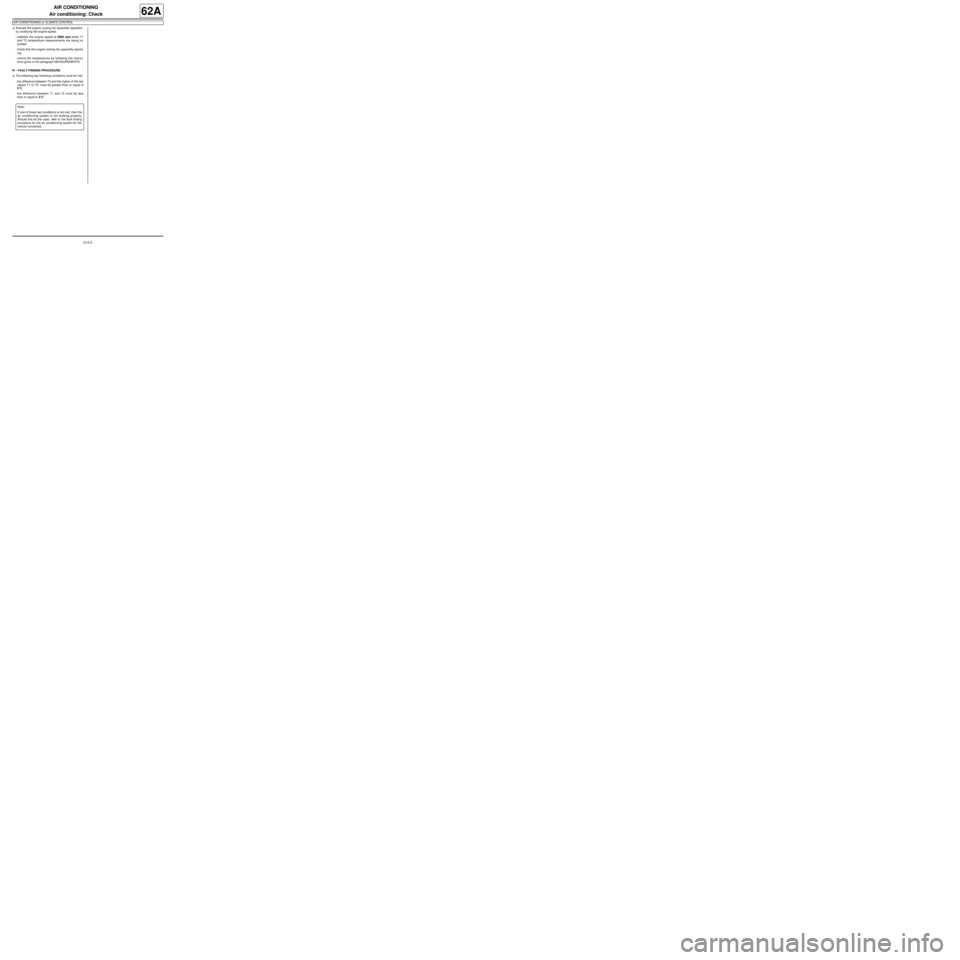
62A-6
AIR CONDITIONING
Air conditioning: Check
AIR CONDITIONING or CLIMATE CONTROL
62A
aActivate the engine cooling fan assembly operation
by modifying the engine speed.
-stabilise the engine speed at 2000 rpm while T1
and T2 temperature measurements are being re-
corded.
-check that the engine cooling fan assembly operat-
ing.
-record the temperatures by following the instruc-
tions given in the paragraph MEASUREMENTS.
IV - FAULT FINDING PROCEDURE
aThe following two following conditions must be met:
-the difference between T3 and the higher of the two
values T1 or T2, must be greater than or equal to
5˚C,
-the difference between T1 and T2 must be less
than or equal to 2˚C.
Note:
If one of these two conditions is not met, then the
air conditioning system is not working properly.
Should this be the case, refer to the fault finding
procedure for the air conditioning system for the
vehicle concerned.
Page 88 of 122
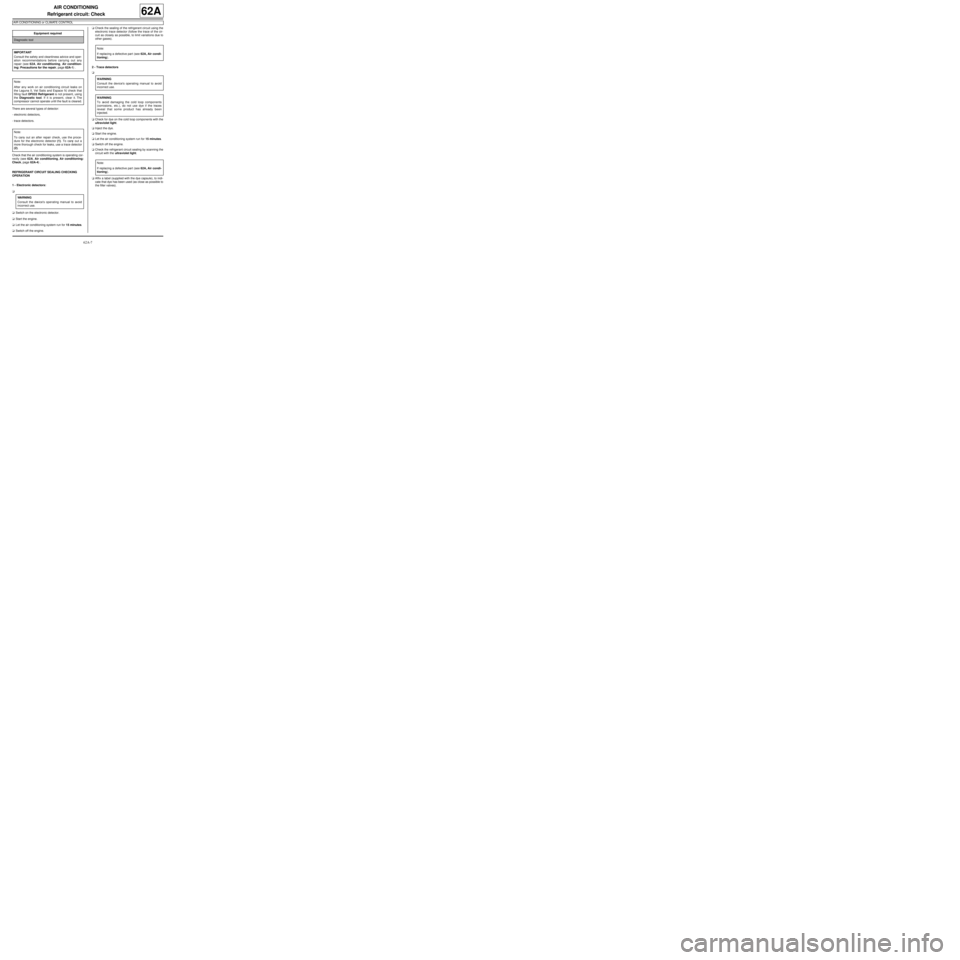
62A-7
AIR CONDITIONING
Refrigerant circuit: Check
AIR CONDITIONING or CLIMATE CONTROL
62A
There are several types of detector:
-electronic detectors,
-trace detectors.
Check that the air conditioning system is operating cor-
rectly (see 62A, Air conditioning, Air conditioning:
Check, page 62A-4) .
REFRIGERANT CIRCUIT SEALING CHECKING
OPERATION
1 - Electronic detectors:
a
aSwitch on the electronic detector.
aStart the engine.
aLet the air conditioning system run for 15 minutes.
aSwitch off the engine.aCheck the sealing of the refrigerant circuit using the
electronic trace detector (follow the trace of the cir-
cuit as closely as possible, to limit variations due to
other gases).
2 - Trace detectors
a
aCheck for dye on the cold loop components with the
ultraviolet light.
aInject the dye.
aStart the engine.
aLet the air conditioning system run for 15 minutes.
aSwitch off the engine.
aCheck the refrigerant circuit sealing by scanning the
circuit with the ultraviolet light.
aAffix a label (supplied with the dye capsule), to indi-
cate that dye has been used (as close as possible to
the filler valves). Equipment required
Diagnostic tool
IMPORTANT
Consult the safety and cleanliness advice and oper-
ation recommendations before carrying out any
repair (see 62A, Air conditioning, Air condition-
ing: Precautions for the repair, page 62A-1) .
Note:
After any work on air conditioning circuit leaks on
the Laguna II, Vel Satis and Espace IV, check that
filling fault DF033 Refrigerant is not present, using
the Diagnostic tool. If it is present, clear it. The
compressor cannot operate until the fault is cleared.
Note:
To carry out an after repair check, use the proce-
dure for the electronic detector (1). To carry out a
more thorough check for leaks, use a trace detector
(2).
WARNING
Consult the device's operating manual to avoid
incorrect use.
Note:
If replacing a defective part (see 62A, Air condi-
tioning).
WARNING
Consult the device's operating manual to avoid
incorrect use.
WARNING
To avoid damaging the cold loop components
(corrosions , etc.), do not use dye if the traces
reveal that some product has already been
injected.
Note:
If replacing a defective part (see 62A, Air condi-
tioning).
Page 89 of 122
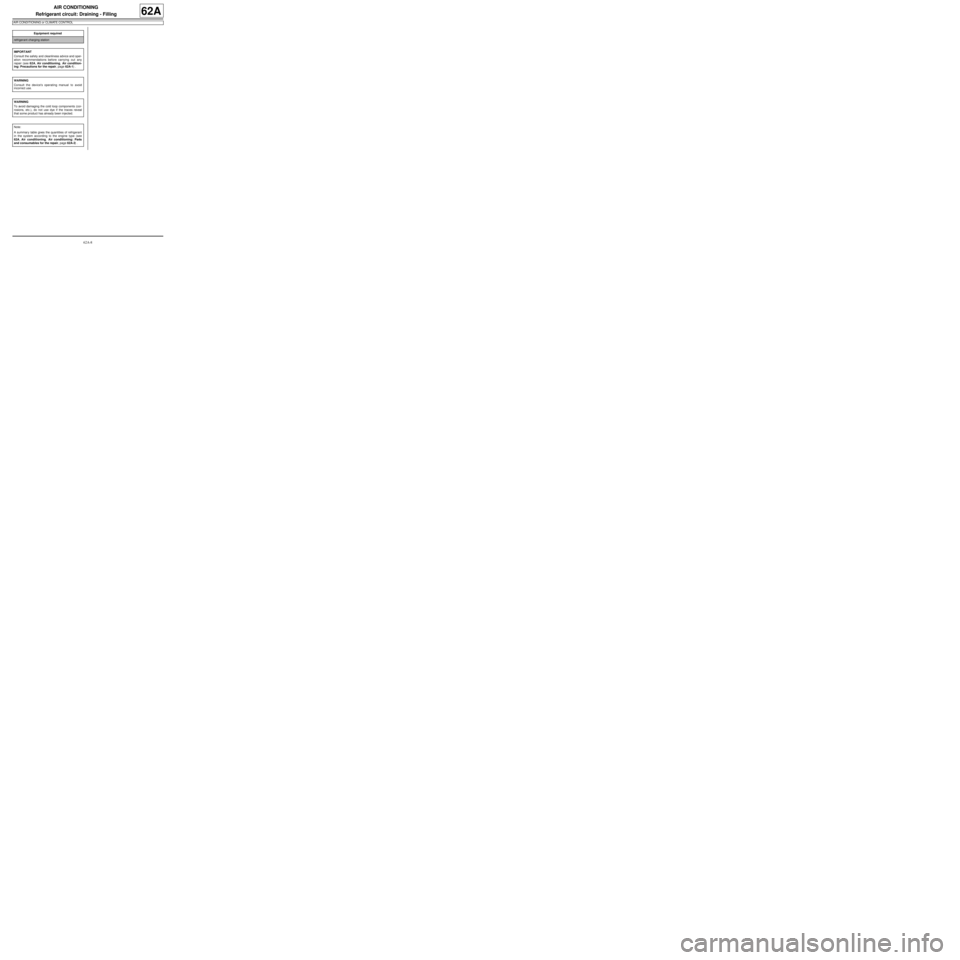
62A-8
AIR CONDITIONING
Refrigerant circuit: Draining - Filling
AIR CONDITIONING or CLIMATE CONTROL
62A
Equipment required
refrigerant charging station
IMPORTANT
Consult the safety and cleanliness advice and oper-
ation recommendations before carrying out any
repair (see 62A, Air conditioning, Air condition-
ing: Precautions for the repair, page 62A-1) .
WARNING
Consult the device's operating manual to avoid
incorrect use.
WARNING
To avoid damaging the cold loop components (cor-
rosions, etc.), do not use dye if the traces reveal
that some product has already been injected.
Note:
A summary table gives the quantities of refrigerant
in the system according to the engine type (see
62A, Air conditioning, Air conditioning: Parts
and consumables for the repair, page 62A-2) .
Page 90 of 122
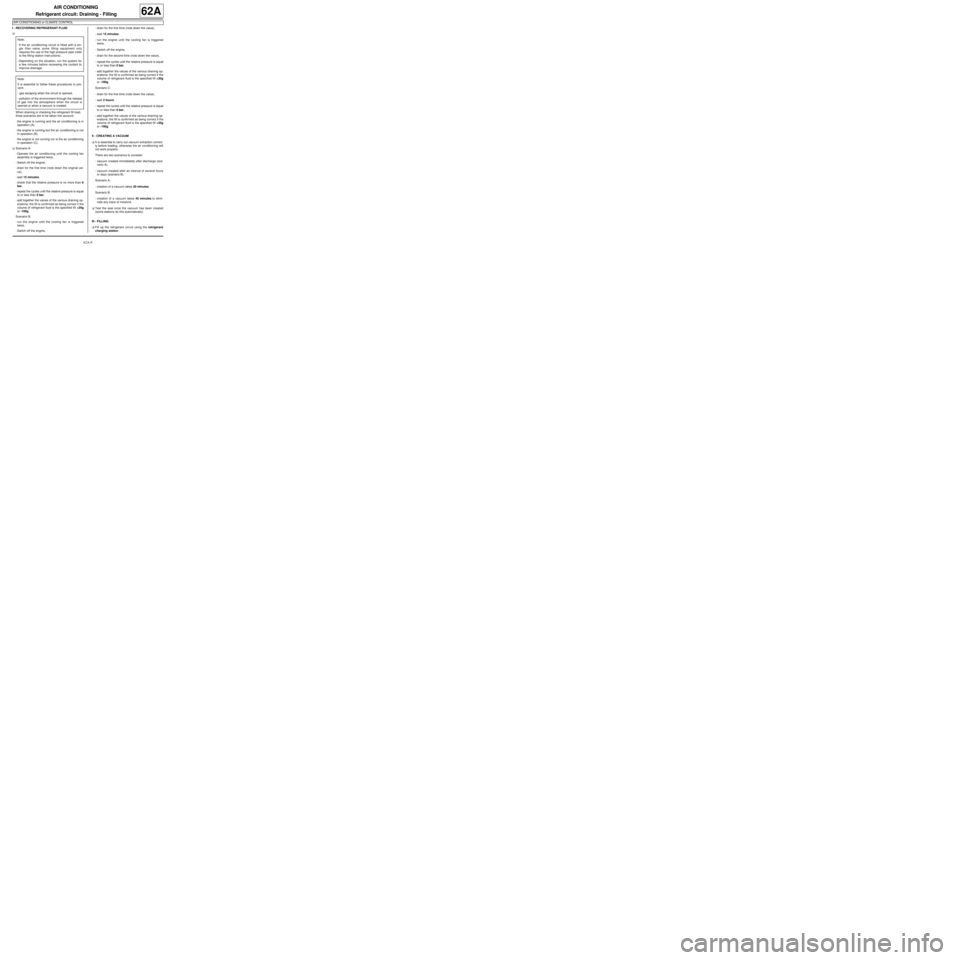
62A-9
AIR CONDITIONING
Refrigerant circuit: Draining - Filling
AIR CONDITIONING or CLIMATE CONTROL
62A
I - RECOVERING REFRIGERANT FLUID
a
When draining or checking the refrigerant fill load,
three scenarios are to be taken into account:
-the engine is running and the air conditioning is in
operation (A),
-the engine is running but the air conditioning is not
in operation (B),
-the engine is not running nor is the air conditioning
in operation (C).
aScenario A:
-Operate the air conditioning until the cooling fan
assembly is triggered twice,
-Switch off the engine,
-drain for the first time (note down the original val-
ue),
-wait 15 minutes,
-check that the relative pressure is no more than 0
bar,
-repeat the cycles until the relative pressure is equal
to or less than 0 bar,
-add together the values of the various draining op-
erations; the fill is confirmed as being correct if the
volume of refrigerant fluid is the specified fill +35g
or -100g.
Scenario B:
-run the engine until the cooling fan is triggered
twice,
-Switch off the engine,-drain for the first time (note down the value),
-wait 15 minutes,
-run the engine until the cooling fan is triggered
twice,
-Switch off the engine,
-drain for the second time (note down the value),
-repeat the cycles until the relative pressure is equal
to or less than 0 bar,
-add together the values of the various draining op-
erations; the fill is confirmed as being correct if the
volume of refrigerant fluid is the specified fill +35g
or -100g.
Scenario C:
-drain for the first time (note down the value),
-wait 2 hours,
-repeat the cycles until the relative pressure is equal
to or less than 0 bar,
-add together the values of the various draining op-
erations; the fill is confirmed as being correct if the
volume of refrigerant fluid is the specified fill +35g
or -100g.
II - CREATING A VACUUM
aIt is essential to carry out vacuum extraction correct-
ly before loading, otherwise the air conditioning will
not work properly.
There are two scenarios to consider:
-vacuum created immediately after discharge (sce-
nario A),
-vacuum created after an interval of several hours
or days (scenario B).
Scenario A:
-creation of a vacuum takes 20 minutes.
Scenario B:
-creation of a vacuum takes 45 minutes to elimi-
nate any trace of moisture.
aTest the seal once the vacuum has been created
(some stations do this automatically).
III - FILLING
aFill up the refrigerant circuit using the refrigerant
charging station. Note:
-If the air conditioning circuit is fitted with a sin-
gle filler valve, some filling equipment only
requires the use of the high pressure pipe (refer
to the filling station instructions).
-Depending on the situation, run the system for
a few minutes before recovering the coolant to
improve drainage.
Note:
It is essential to follow these procedures to pre-
vent:
- gas escaping when the circuit is opened,
- pollution of the environment through the release
of gas into the atmosphere when the circuit is
opened or when a vacuum is created.
Page 91 of 122
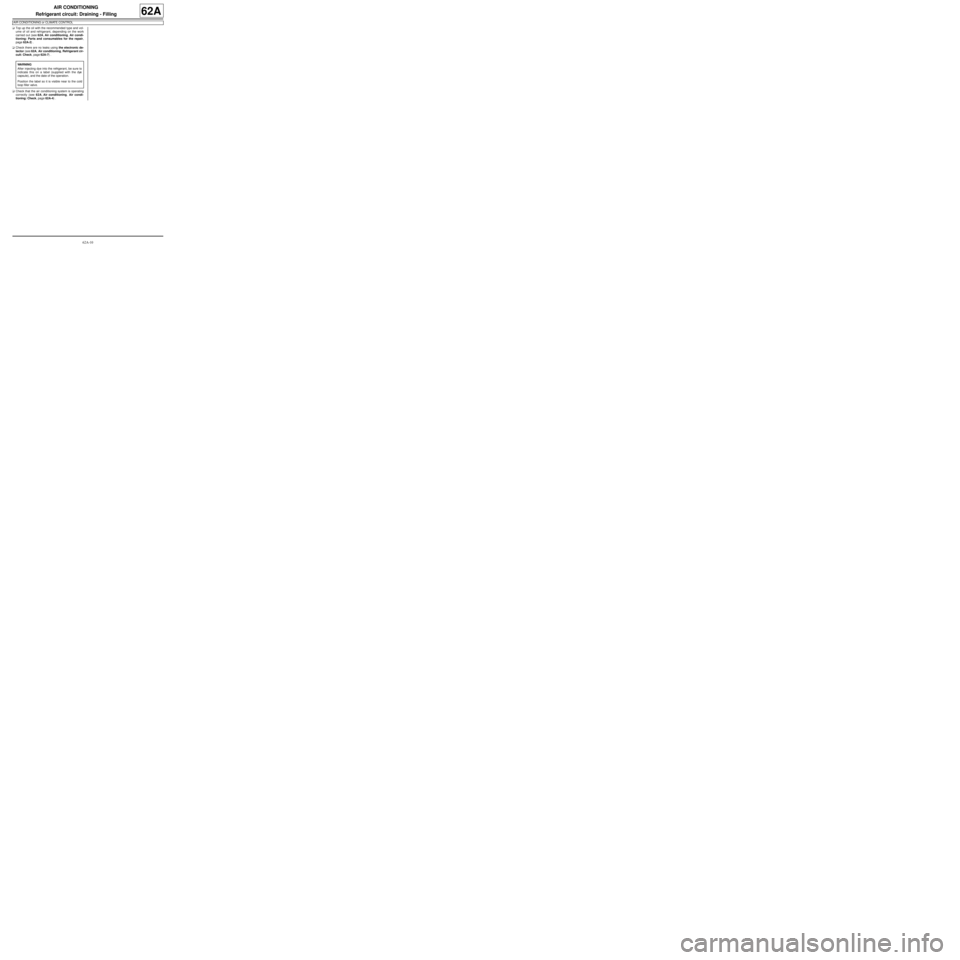
62A-10
AIR CONDITIONING
Refrigerant circuit: Draining - Filling
AIR CONDITIONING or CLIMATE CONTROL
62A
aTop up the oil with the recommended type and vol-
ume of oil and refrigerant, depending on the work
carried out (see 62A, Air conditioning, Air condi-
tioning: Parts and consumables for the repair,
page 62A-2) .
aCheck there are no leaks using the electronic de-
tector (see 62A, Air conditioning, Refrigerant cir-
cuit: Check, page 62A-7) .
aCheck that the air conditioning system is operating
correctly (see 62A, Air conditioning, Air condi-
tioning: Check, page 62A-4) . WARNING
After injecting dye into the refrigerant, be sure to
indicate this on a label (supplied with the dye
capsule), and the date of the operation.
Position the label so it is visible near to the cold
loop filler valve.
Page 92 of 122
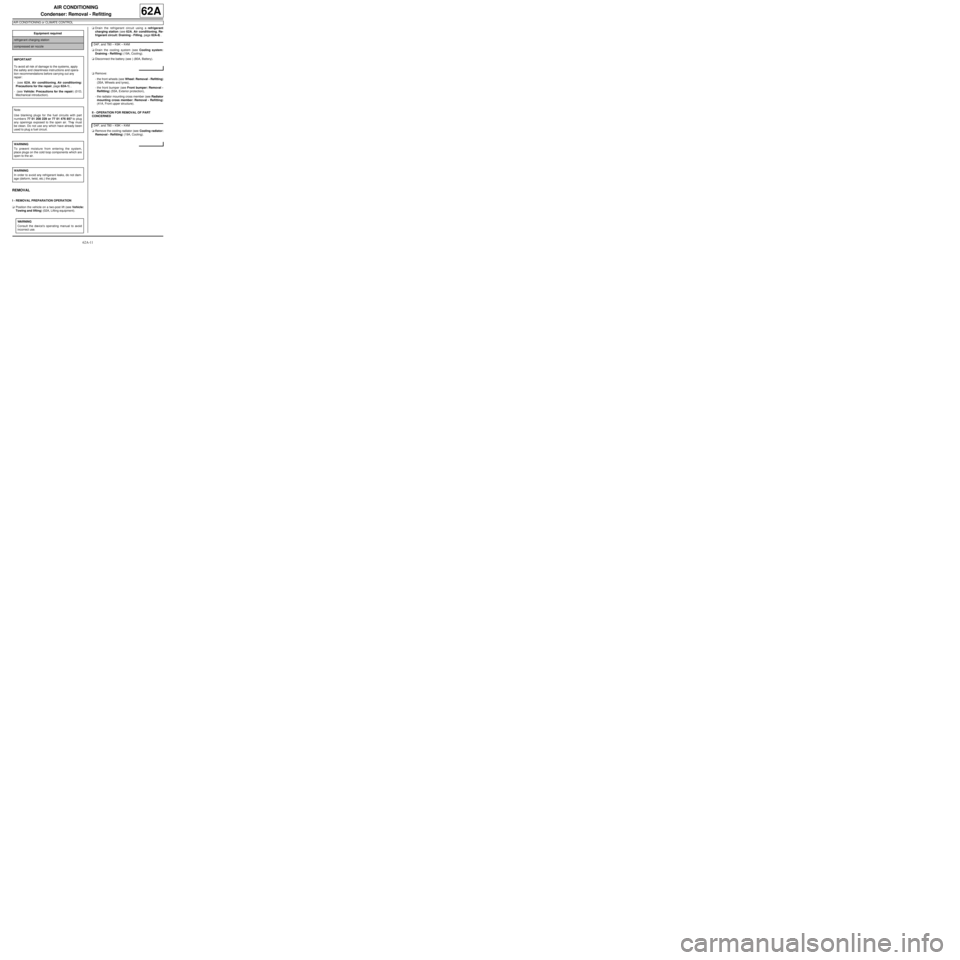
62A-11
AIR CONDITIONING
Condenser: Removal - Refitting
AIR CONDITIONING or CLIMATE CONTROL
62A
REMOVAL
I - REMOVAL PREPARATION OPERATION
aPosition the vehicle on a two-post lift (see Vehicle:
Towing and lifting) (02A, Lifting equipment).aDrain the refrigerant circuit using a refrigerant
charging station (see 62A, Air conditioning, Re-
frigerant circuit: Draining - Filling, page 62A-8) .
aDrain the cooling system (see Cooling system:
Draining - Refilling) (19A, Cooling).
aDisconnect the battery (see ) (80A, Battery).
aRemove:
-the front wheels (see Wheel: Removal - Refitting)
(35A, Wheels and tyres),
-the front bumper (see Front bumper: Removal -
Refitting) (55A, Exterior protection),
-the radiator mounting cross member (see Radiator
mounting cross member: Removal - Refitting)
(41A, Front upper structure).
II - OPERATION FOR REMOVAL OF PART
CONCERNED
aRemove the cooling radiator (see Cooling radiator:
Removal - Refitting) (19A, Cooling). Equipment required
refrigerant charging station
compressed air nozzle
IMPORTANT
To avoid all risk of damage to the systems, apply
the safety and cleanliness instructions and opera-
tion recommendations before carrying out any
repair:
- (see 62A, Air conditioning, Air conditioning:
Precautions for the repair, page 62A-1) ,
- (see Vehicle: Precautions for the repair) (01D,
Mechanical introduction).
Note:
Use blanking plugs for the fuel circuits with part
numbers 77 01 208 229 or 77 01 476 857 to plug
any openings exposed to the open air. They must
be clean. Do not use any which have already been
used to plug a fuel circuit.
WARNING
To prevent moisture from entering the system,
place plugs on the cold loop components which are
open to the air.
WARNING
In order to avoid any refrigerant leaks, do not dam-
age (deform, twist, etc.) the pipe.
WARNING
Consult the device's operating manual to avoid
incorrect use.D4F, and 780 – K9K – K4M
D4F, and 780 – K9K – K4M
Page 93 of 122
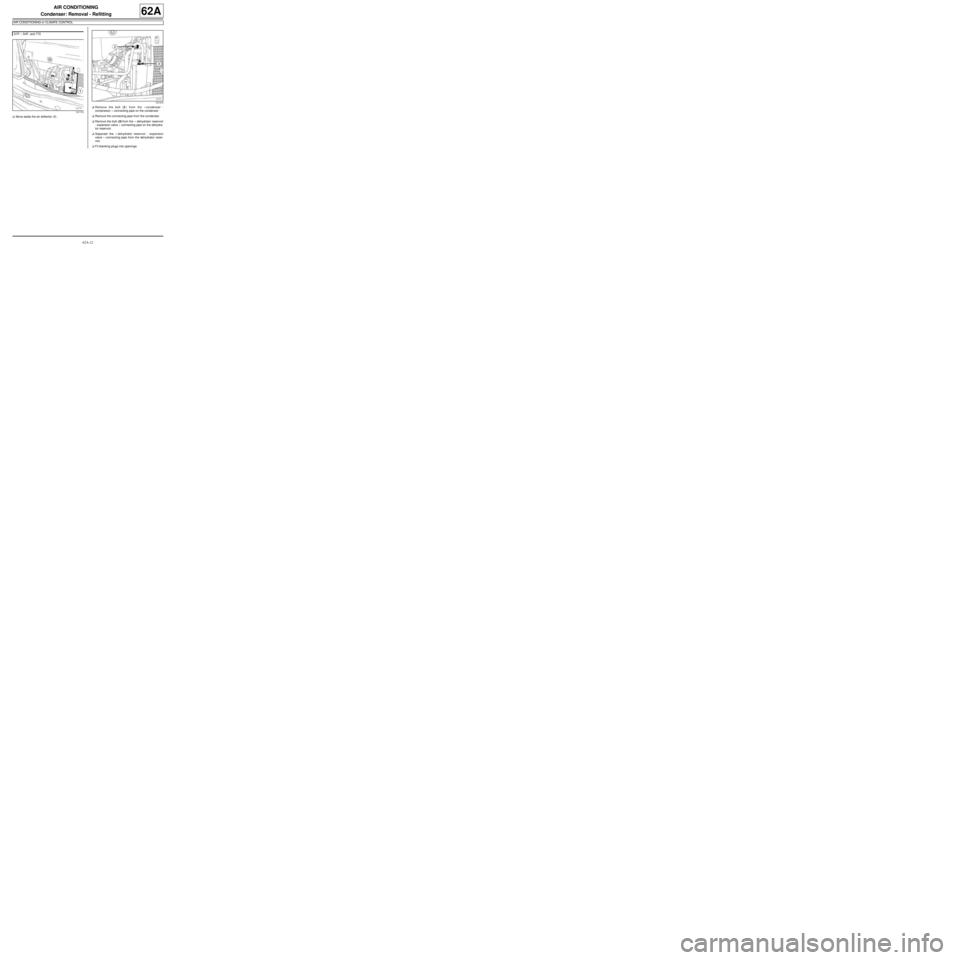
62A-12
AIR CONDITIONING
Condenser: Removal - Refitting
AIR CONDITIONING or CLIMATE CONTROL
62A
aMove aside the air deflector (1) .aRemove the bolt (2) from the « condenser -
compressor » connecting pipe on the condenser.
aRemove the connecting pipe from the condenser.
aRemove the bolt (3) from the « dehydrator reservoir
- expansion valve » connecting pipe on the dehydra-
tor reservoir.
aSeparate the « dehydrator reservoir - expansion
valve » connecting pipe from the dehydrator reser-
voir.
aFit blanking plugs into openings. D7F – D4F, and 772
121174
121312
Page 94 of 122
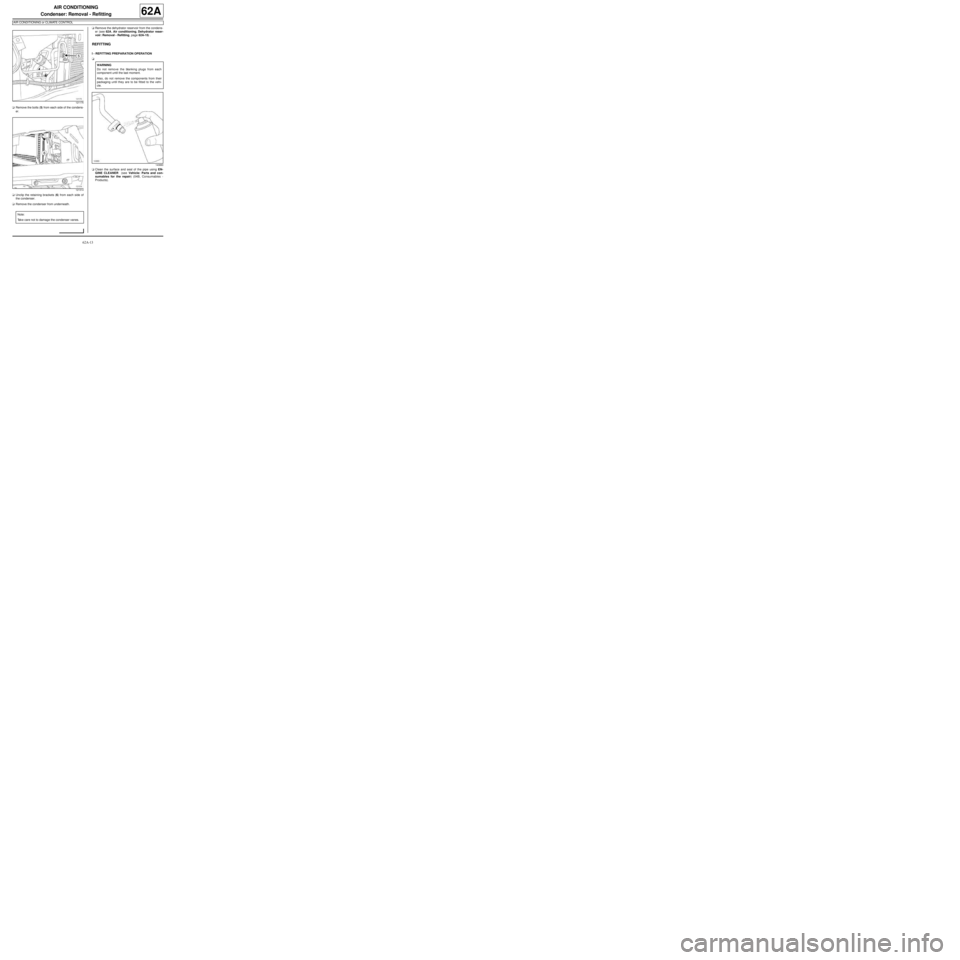
62A-13
AIR CONDITIONING
Condenser: Removal - Refitting
AIR CONDITIONING or CLIMATE CONTROL
62A
aRemove the bolts (5) from each side of the condens-
er.
aUnclip the retaining brackets (6) from each side of
the condenser.
aRemove the condenser from underneath.aRemove the dehydrator reservoir from the condens-
er (see 62A, Air conditioning, Dehydrator reser-
voir: Removal - Refitting, page 62A-15) .
REFITTING
I - REFITTING PREPARATION OPERATION
a
aClean the surface and seal of the pipe using EN-
GINE CLEANER (see Vehicle: Parts and con-
sumables for the repair) (04B, Consumables -
Products).
121175
121314
Note:
Take care not to damage the condenser vanes.
WARNING
Do not remove the blanking plugs from each
component until the last moment.
Also, do not remove the components from their
packaging until they are to be fitted to the vehi-
cle.
143880
Page 95 of 122
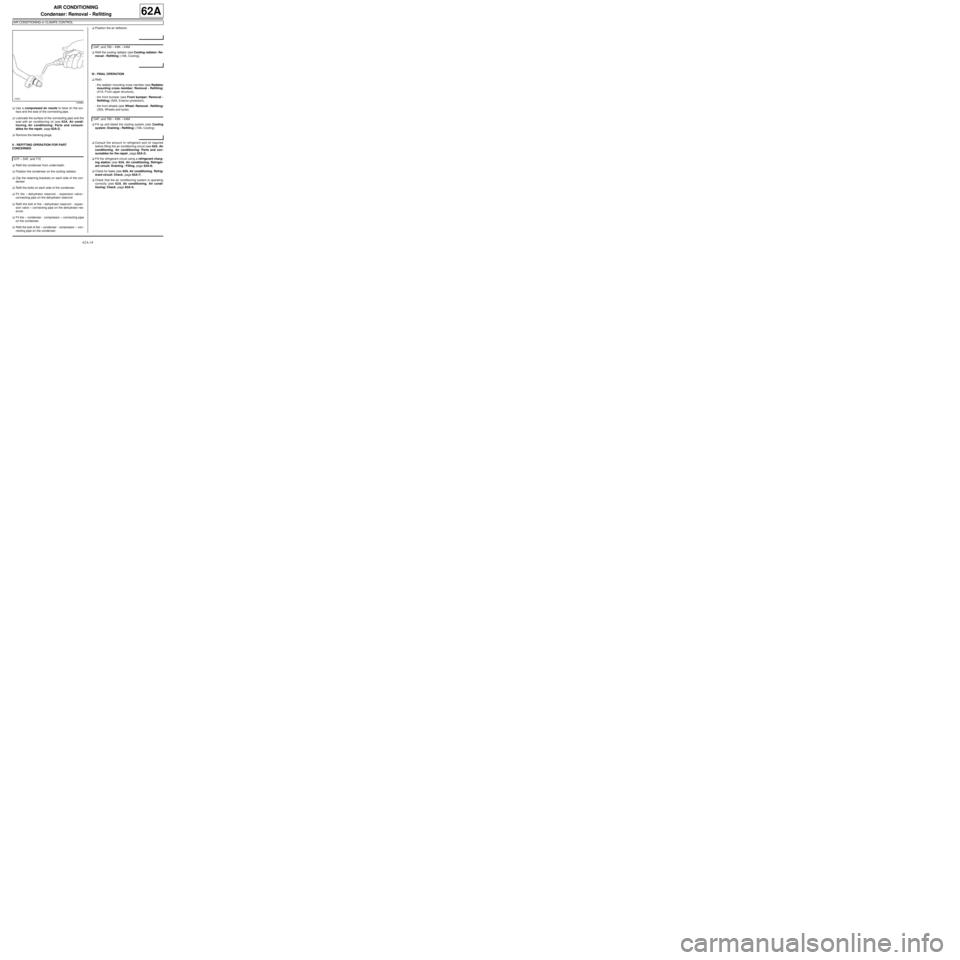
62A-14
AIR CONDITIONING
Condenser: Removal - Refitting
AIR CONDITIONING or CLIMATE CONTROL
62A
aUse a compressed air nozzle to blow on the sur-
face and the seal of the connecting pipe.
aLubricate the surface of the connecting pipe and the
seal with air conditioning oil (see 62A, Air condi-
tioning, Air conditioning: Parts and consum-
ables for the repair, page 62A-2) .
aRemove the blanking plugs.
II - REFITTING OPERATION FOR PART
CONCERNED
aRefit the condenser from underneath.
aPosition the condenser on the cooling radiator.
aClip the retaining brackets on each side of the con-
denser.
aRefit the bolts on each side of the condenser.
aFit the « dehydrator reservoir - expansion valve »
connecting pipe on the dehydrator reservoir.
aRefit the bolt of the « dehydrator reservoir - expan-
sion valve » connecting pipe on the dehydrator res-
ervoir.
aFit the « condenser - compressor » connecting pipe
on the condenser.
aRefit the bolt of the « condenser - compressor » con-
necting pipe on the condenser.aPosition the air deflector.
aRefit the cooling radiator (see Cooling radiator: Re-
moval - Refitting) (19A, Cooling).
III - FINAL OPERATION
aRefit:
-the radiator mounting cross member (see Radiator
mounting cross member: Removal - Refitting)
(41A, Front upper structure),
-the front bumper (see Front bumper: Removal -
Refitting) (55A, Exterior protection),
-the front wheels (see Wheel: Removal - Refitting)
(35A, Wheels and tyres).
aFill up and bleed the cooling system (see Cooling
system: Draining - Refilling) (19A, Cooling).
aConsult the amount of refrigerant and oil required
before filling the air conditioning circuit (see 62A, Air
conditioning, Air conditioning: Parts and con-
sumables for the repair, page 62A-2) .
aFill the refrigerant circuit using a refrigerant charg-
ing station (see 62A, Air conditioning, Refriger-
ant circuit: Draining - Filling, page 62A-8) .
aCheck for leaks (see 62A, Air conditioning, Refrig-
erant circuit: Check, page 62A-7) .
aCheck that the air conditioning system is operating
correctly (see 62A, Air conditioning, Air condi-
tioning: Check, page 62A-4) .
143882
D7F – D4F, and 772
D4F, and 780 – K9K – K4M
D4F, and 780 – K9K – K4M
Page 96 of 122
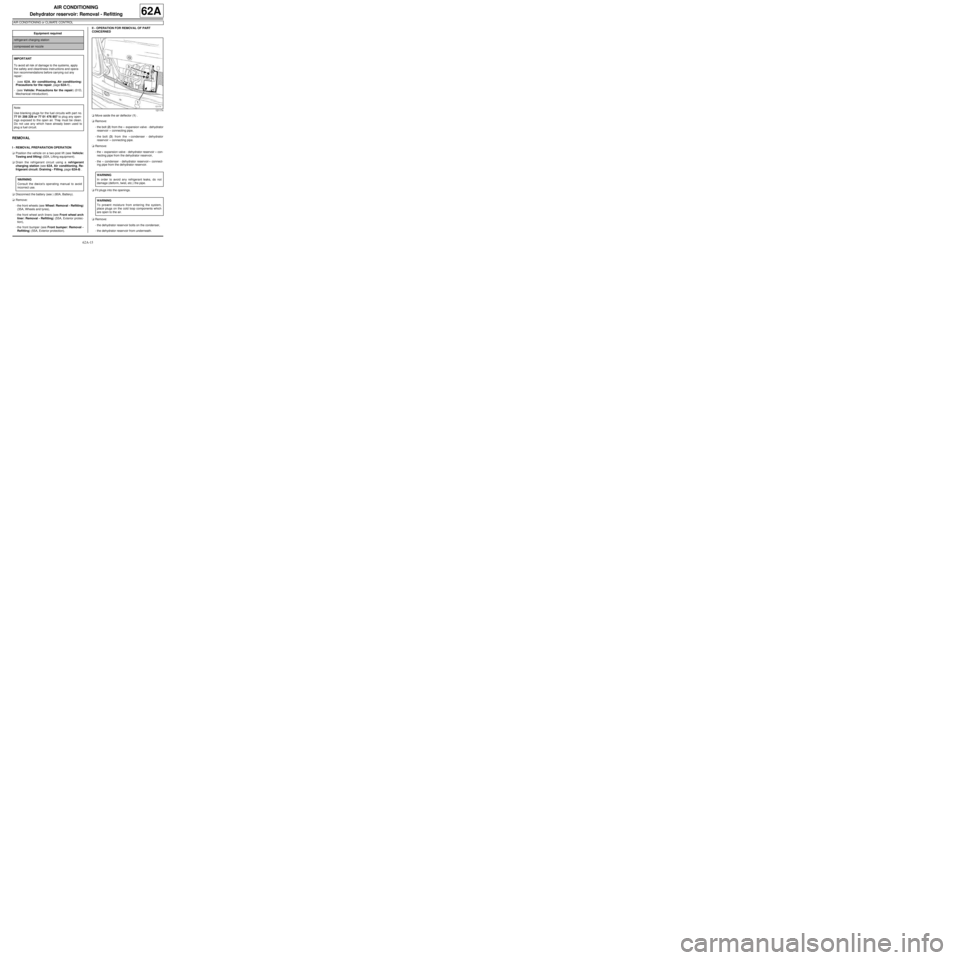
62A-15
AIR CONDITIONING
Dehydrator reservoir: Removal - Refitting
AIR CONDITIONING or CLIMATE CONTROL
62A
REMOVAL
I - REMOVAL PREPARATION OPERATION
aPosition the vehicle on a two-post lift (see Vehicle:
Towing and lifting) (02A, Lifting equipment).
aDrain the refrigerant circuit using a refrigerant
charging station (see 62A, Air conditioning, Re-
frigerant circuit: Draining - Filling, page 62A-8) .
aDisconnect the battery (see ) (80A, Battery).
aRemove:
-the front wheels (see Wheel: Removal - Refitting)
(35A, Wheels and tyres),
-the front wheel arch liners (see Front wheel arch
liner: Removal - Refitting) (55A, Exterior protec-
tion),
-the front bumper (see Front bumper: Removal -
Refitting) (55A, Exterior protection).II - OPERATION FOR REMOVAL OF PART
CONCERNED
aMove aside the air deflector (1) .
aRemove:
-the bolt (2) from the « expansion valve - dehydrator
reservoir » connecting pipe,
-the bolt (3) from the « condenser - dehydrator
reservoir » connecting pipe.
aRemove:
-the « expansion valve - dehydrator reservoir » con-
necting pipe from the dehydrator reservoir,
-the « condenser - dehydrator reservoir » connect-
ing pipe from the dehydrator reservoir.
aFit plugs into the openings.
aRemove:
-the dehydrator reservoir bolts on the condenser,
-the dehydrator reservoir from underneath. Equipment required
refrigerant charging station
compressed air nozzle
IMPORTANT
To avoid all risk of damage to the systems, apply
the safety and cleanliness instructions and opera-
tion recommendations before carrying out any
repair:
- (see 62A, Air conditioning, Air conditioning:
Precautions for the repair, page 62A-1) ,
- (see Vehicle: Precautions for the repair) (01D,
Mechanical introduction).
Note:
Use blanking plugs for the fuel circuits with part no.
77 01 208 229 or 77 01 476 857 to plug any open-
ings exposed to the open air. They must be clean.
Do not use any which have already been used to
plug a fuel circuit.
WARNING
Consult the device's operating manual to avoid
incorrect use.
121174
WARNING
In order to avoid any refrigerant leaks, do not
damage (deform, twist, etc.) the pipe.
WARNING
To prevent moisture from entering the system,
place plugs on the cold loop components which
are open to the air.